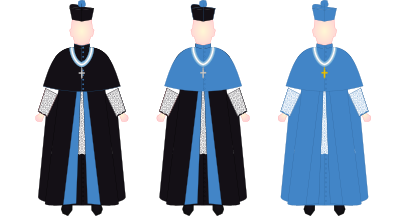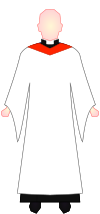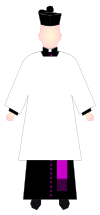Choir dress
This article needs additional citations for verification. (March 2013) |



Choir dress is the traditional vesture of the
Like
Roman Catholic choir dress
Choir dress in the Catholic Church is worn by deacons, priests, regular prelates, bishops and cardinals when presiding at or celebrating a liturgy that is not the Mass, especially the Liturgy of the Hours. Before the Second Vatican Council, the dress was more elaborate. It had dozens of varieties and colours. After The Second Vatican Council, it was reduced; however, exceptions are sometimes granted for cathedral chapters.
The current dress is worn when attending Mass without celebrating or observing the Eucharist. It is worn by seminarians, instituted lectors and acolytes, and altar servers and choir members at Mass or other liturgical events.
The basic components of choir dress are:
- the fascia(fringed sash worn around the waist),
- if the person is a brother or priest in a religious order that has its own habit (Benedictines, Franciscans, Dominicans, etc.), the habit is worn in place of the cassock,
- the canon), and
- the biretta (optional for secular priests unless their bishop requires its use, in which case it is mandatory).
For
the cassock is exactly the same as their normal cassock: a black cassock with black buttons, girded with a black fascia.Priests who hold additional honors may wear a different cassock:
Bishops wear the above-mentioned purple cassock with scarlet piping, and add a
The
Lay brothers also have a form of choir dress: the full monastic habit with the monastic cowl is their formal wear for attending the Liturgy of the Hours or Mass.
Since 2006, priests of the
The blue stands for our complete dedication to the
Blessed Mother and is traditionally the color shown on St. Francis de Sales in most paintings of him," and "The choir dress expresses the strong unity, spiritually, and identity of the Institute and adds solemnity to the liturgy."— "Frequently Asked Questions". institute-christ-king.org. Archived from the originalon 8 September 2018. Retrieved 17 September 2018.
 |
| Priests, superiors and prior general of the Institute of Christ the King Sovereign Priest |
Eastern choir dress
The choir dress of clergy in the
Byzantine Rite
In Eastern Orthodoxy and
Monastic clergy wear different headcoverings than married clergy. Married clergy wear either a colored
A ruling Igumen (so long as he is inside his own monastery) and a bishop may carry his
In North America and Great Britain, some Orthodox clergy have begun to wear a
Examples
There exist color and design variations in each
 |
 |
 |
 |
| Patriarch (Slavic) | Metropolitan (Slavic) | Bishop (Slavic) | Bishop (Greek) |
 |
 |
 |
 |
 |
| Priest | Hieromonk | Schemamonk | Monk | Reader/Subdeacon/Deacon |
Oriental Orthodox
 |
 |
 |
 |
 |
| Syriac Patriarch | Syriac Bishop | Coptic Priest | Syriac Priest | Syriac Priest (monk) |
In the
Anglican choir dress or choir habit


Choir dress in Anglicanism traditionally consists of cassock, surplice and scarf (or tippet).[n 1] An academic hood may also be worn. Since 1964 in the Church of England, a cope may be worn at the discretion of the minister.[2]
But, the basic garment was, and is, the surplice, which by the fourteenth century had become the essential choir vestment everywhere.[3] The surplice was the only vesture permitted to the clergy in the 1552 Prayer Book, except for bishops, who should use a rochet (both wore cassocks as the standard undergarment).[4] The Elizabethan Prayer Book of 1559 included the so-called Ornaments Rubric. Its legal interpretation was disputed in the nineteenth century;[5] it was claimed that its inclusion in the 1662 Book of Common Prayer commanded the pre-Reformation Eucharistic vestments (chasuble, dalmatic, tunicle, alb, amice, and maniple) that had been in use during the reign of Edward VI.[4] However, the Elizabethan bishops struggled to enforce the use of the surplice.[4] The use of Eucharistic vestments was discontinued until after the Oxford Movement, in the middle of the nineteenth century, when it was restored in many cathedrals and parish churches.[3] In many low-church dioceses and parishes, the choir dress continued to be the norm, even at the Eucharist. The cope continued in use for coronations and in certain cathedrals, but this may be considered an extension of "choir dress" and was sanctioned by the canons of 1603/4.[6]
The
Chaplains in the Armed Forces wear tippets with officially sanctioned badges and any medals they have achieved. A bishop or priest may wear a tippet with the arms of the seminary from which he or she received their degree. In England, some cathedral clergy wear tippets on which is embroidered the distinctive symbol or cathedral coat of arms. Members of the high church, or Anglo-Catholic parts of the church, sometimes wear choir dress of a more Roman Catholic style, including a shorter surplice (or cotta), a stole (and sometimes a biretta), excluding hood and tippet.
Readers when officiating often wear a blue tippet, or, in the United States, a black tippet displaying the arms of the diocese. At the Eucharist, readers of Scripture may wear street clothing to emphasize the role of the laity, as expressed in recent versions of the Prayer Book. But, in some parishes readers wear the traditional vestments of the subdeacon at High Mass: alb fastened with a white cincture and a tunicle. In other parishes they wear the cassock and surplice, as do members of the choir.
Anglican bishops usually wear a purple cassock. Over this they wear the rochet with red or black chimere and matching cuffs, black tippet, and sometimes an academic hood.
 |
 |
 |
 |
 |
| Bishop | Canon (cassock colors vary) | Priest or Deacon | Reader | Layperson |
References
Notes
- ^ Tippet is often used as a synonym of "scarf", but historically it may also have been used in the sixteenth and seventeenth centuries for a type of non-academic hood that extended forward down over the chest.(Cross & Livingstone 1974, "Tippet")
Citations
- ^ a b Grisebrooke 1978, p. 489, Vestments.
- ^ Canons of 1964 and following years: B.8.3
- ^ a b Simpson, John A. arts "Surplice" & "Vestments" in The New International Dictionary of the Christian Church J.D. Douglas(ed.) Exeter: Paternoster (1974)
- ^ a b c Procter & Frere. A New History of the Book of Common Prayer, MacMillan (1902), pp. 82; 362ff & 110, respectively.
- ^ Cross & Livingstone 1974, "Ornaments Rubric, The".
- ^ Davis 1869, p. 25, Canon 24.
- ^ Davis 1869, p. 73, Canon 74 of 1603/04 replaced by C.27
Sources
- Cross, F.L.; Livingstone, E.A., eds. (1974). The Oxford Dictionary of the Christian Church (2nd ed.). Oxford: University Press.
- Davis, C.H. (1869). The English Church Canons of 1604: With Historical Introduction and Notes, Critical and Explanatory, Showing the Modifications of Each Canon by Subsequent Acts of Parliament, Etc. H. Sweet.
- Grisebrooke, W. Jardine (1978). "Vestments". In Jones, C.; Wainwright, G.; Yarnold, E. (eds.). The Study of Liturgy. SPCK. ISBN 978-0-281-03578-6.
External links
- Dress of Roman Catholic Clergy
- The Mozzetta Information and photos
- The Mantelletta
- Canons
- Chaplains of His Holiness detailed information on the choir dress of prelates of the papal household both before and after Vatican II








